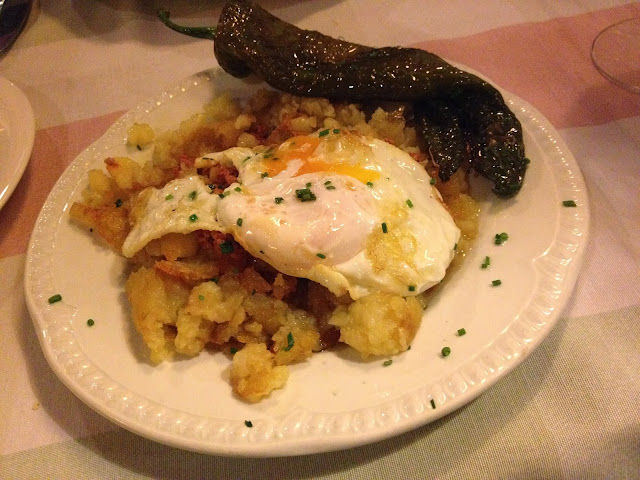We were supposed to head south on the A-4 but the directions referred to a roundabout that never showed up and somehow we were headed southwest on the A-5 instead. There were a lot of tunnels involved.
I had spent a LOT of time preparing for this trip with Google maps - I printed out detailed directions for each leg of our trip and spent probably hours reviewing them in Street View, but nonetheless we immediately learned that if you take a wrong turn, printed out directions become instantly useless. Fortunately, I had also downloaded Triposo's Spain app, which comes with offline maps of the entire country. An iPhone has built in GPS that does not require a service connection, and these two things combined saved us dozens of times on this trip. The Triposo app was free but I'm going to write them an email offering to paypal them some money. It was absolutely invaluable for getting and keeping us on track. With the help of Triposo I was able to get us back over to the A-4 and then we drove the four hours to Cordoba without further incident.
In Cordoba we stayed in the Hotel Hacienda Posada de Vallina, which is located immediately across the street from Cordoba's biggest tourist site, the Mezquita. I couldn't understand why the hotel wasn't featured in any of the guidebooks we had, because not only was the location was perfect, it was easy to get to by car and provided parking, both of which are relatively rare in Andalucian cities. It is also beautiful, having been built in the 13th century. Supposedly Christopher Columbus even slept there! Very exciting. Here is the interior courtyard.
Once we were actually in Cordoba, though, I understood why it doesn't have a higher profile - there are literally dozens of hotels in the tourist area around the Mezquita, and I'm sure most of them are lovely.
The first thing we did after parking the car was EAT. We went to Bodegas Mezquita because it was just down the block from our hotel and Rick Steves said it was good. Basically we spent most of this trip doing whatever Rick Steves said we should do. We got the menu de tapas, which featured the following items:
Like every single thing we ate in Spain, it was all really good.
A lot of people do a day trip from Seville rather than spending the night in Cordoba, because the Mezquita is considered to be the only major sight worth seeing. It was built as a huge mosque during the Moorish occupation of Spain (which lasted 700 years, so it's not really all that accurate to actually think of it as an "occupation"). When the Christians reconquered Cordoba, they tore out the middle of the mosque and built a huge cathedral in the center.
We checked it out after lunch. There is a big courtyard inside the walls.
And here are the famous arches from the mosque section. There are probably thousands of pictures exactly like this on the internet, but it's impossible not to take and post them yourself! It is really a beautiful, amazing place.
There are rows and rows of the Islamic columns, and then you come to the middle, where there is this huge cathedral built right into the center. The king of Spain approved this idea over the objections of Cordobans who wanted to preserve the building even after the Moors had left.
Here is our hotel from inside the Mezquita!
And this is the square just outside.
Parts of the old city wall still remain.
This little dog came over to say hi to me.
After the Mezquita we started wandering aimlessly, as per our usual routine in a new place. We ended up in Cordoba's commercial district, which is definitely distinct from the tourist area, unlike most of the other cities we visited.
It was a rainy day, our only one of the trip, so we stood around under the eaves of an old building drinking coffee and people watching for a while. We had our first communication mishap trying to order the coffee - Benjamin kept trying to order a double espresso but was using the terminology he had learned at Starbucks in Madrid, which we later learned is unique to Starbucks. TYPICAL. Anyway, we finally looked up "double" on the Spanish dictionary app to figure it out.
The other touristy thing to do in Cordoba is explore the city's old Jewish quarter, which is whitewashed with tiny narrow streets.
I guess people drive here?
We went down this little alley to discover an artist's collective courtyard type area, which was interesting. Lots of little shops with artwork to buy.
We also ran across this status of Maimonides, an important Jewish scholar who was born in Cordoba.
That evening we went to Bodegas Campos, another Rick Steves recommendation. It's too bad the picture of Benjamin's dinner didn't come out because it was excellent - chicken rolled up around bacon and then breaded and fried. I ordered fried potatoes and chorizo with an egg, which is my favorite kind of food, and was not disappointed. In Spanish restaurants dishes can generally be ordered in three sizes: as tapas (smallest), half-rations, or rations. I told him I wanted the ration but he said I only needed the half and he was correct.
After dinner it was still drizzly but we wandered around a little bit before turning in.
Cordoba was a great way to start the trip - it's a manageable size and the area around the Mezquita especially is very self-consciously oriented toward tourists, so they are used to people wandering around not knowing how to communicate in Spanish. The next day we were headed out for Granada!





















No comments:
Post a Comment